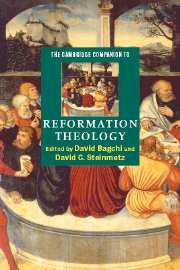Book contents
- Frontmatter
- Introduction
- 1 Late medieval theology
- 2 Lollardy
- 3 Hussite theology and the law of God
- 4 The theology of Erasmus
- 5 Luther
- 6 Melanchthon
- 7 Confessional Lutheran theology
- 8 The theology of Zwingli
- 9 Bucer
- 10 The theology of John Calvin
- 11 John Calvin and later Calvinism
- 12 The theology of Thomas Cranmer
- 13 The theology of the English reformers
- 14 The Scottish Reformation
- 15 An introduction to Anabaptist theology
- 16 Catholic theologians of the Reformation period before Trent
- 17 The Council of Trent
- Conclusion
- Select bibliography
- Index
- Series list
11 - John Calvin and later Calvinism
the identity of the Reformed tradition
Published online by Cambridge University Press: 28 May 2006
- Frontmatter
- Introduction
- 1 Late medieval theology
- 2 Lollardy
- 3 Hussite theology and the law of God
- 4 The theology of Erasmus
- 5 Luther
- 6 Melanchthon
- 7 Confessional Lutheran theology
- 8 The theology of Zwingli
- 9 Bucer
- 10 The theology of John Calvin
- 11 John Calvin and later Calvinism
- 12 The theology of Thomas Cranmer
- 13 The theology of the English reformers
- 14 The Scottish Reformation
- 15 An introduction to Anabaptist theology
- 16 Catholic theologians of the Reformation period before Trent
- 17 The Council of Trent
- Conclusion
- Select bibliography
- Index
- Series list
Summary
Between the middle of the sixteenth century and the beginning of the seventeenth, the Reformed theology of John Calvin and several of his predecessors and contemporaries developed into a significant international movement that has come to be known as 'Calvinism'. As is typically the case in history, the movement was named, not by its proponents, but by its detractors, who took the name of its most famous leader as the basis for a label. The movement itself was in fact fairly diverse - bounded by confessional norms but guided by the thought of a group of founders and formulators rather than by a single person, and developed on an international scale by numerous theologians and exegetes, none of whom took it as their central task to reproduce Calvin’s theology in other times and places. Given this diversity in origin and in development, it is more accurate to speak of 'the Reformed churches' or of 'the Reformed tradition' than of 'Calvinism'.
ROOTS AND BRANCHES – PERSONS AND PLACES
The Reformed or Calvinist tradition is rooted in the Augustinian tradition of the Western church and, in the sixteenth and seventeenth centuries, found its antecedents not only in the works of Augustine himself but in the medieval Augustinian tradition. This is not to say that one must reify a ‘new Augustinian school’ of thought (schola Augustiniana moderna) as some scholars have tended to do, but rather that the Reformed tradition looked to the theology of grace as mediated and developed by a host of medieval thinkers – Aquinas and Scotus among them, as well as theologians of the Augustinian order such as Giles of Rome and Gregory of Rimini.
- Type
- Chapter
- Information
- The Cambridge Companion to Reformation Theology , pp. 130 - 149Publisher: Cambridge University PressPrint publication year: 2004
- 8
- Cited by



